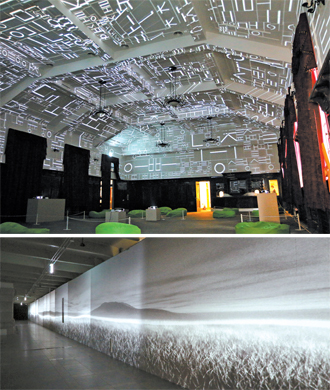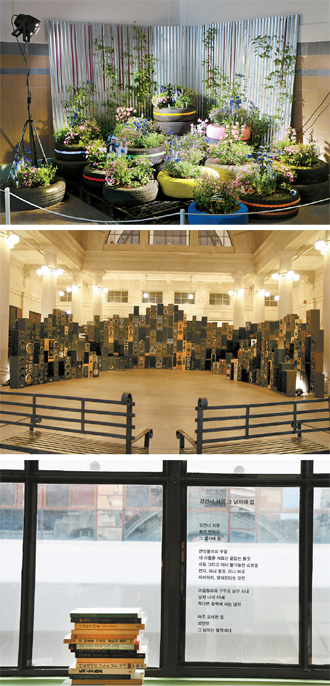Live in haste, repent at leisure: Exhibit extols joys of relaxation

Top: The best way to enjoy “Walk Between the Books” by No Seung-kwan is by laying down on a beanbag chair and looking up. Provided by Culture Station Seoul 284 Bottom: “Landscape, Stand on When and Where” by multiple artists, led by Lee Wu-jun, also known as Kayip.
As the saying goes, all work and no play makes Jack a dull boy; so it is not surprising that too many people in Korea who work too much don’t know how to enjoy their leisure time. According to a survey conducted in 2011 by Statistics Korea, 62 percent of Seoulites spend their free time just watching TV - although 60 percent of them said they would like to travel.
A majority also said they couldn’t enjoy leisure activities because of financial issues.
The question is, then, how best to spend your meager free time without shelling out too much money. For answers, you should check out “How to Enjoy Your Free Time: One Day, Nicely,” an exhibition going on now at Culture Station Seoul 284.
In Korean, the title translates to “The Art of Leisure,” and the exhibition hall is unique, located in the 89-year-old Seoul Train Station. The beautiful, Palladian-style building was turned into a cultural space in 2012.
“How to Enjoy Your Free Time” features works by about 70 artists, working in a wide range of styles and media, like music, installations and media art.
“They have reinterpreted leisure on their own,” said Kim No-am, the director of Culture Station Seoul 284.
The results of their reinterpretations are easy to understand, so that anyone, from young children to grandparents, can find them entertaining and meaningful.
“Since the venue is a cultural complex, we tried to highlight more casual sides than others because Seoul already has plenty of museums and galleries that specialize in fine art,” added Kim.
Located in the heart of Seoul, the free exhibition allows people from all walks of life to walk in and out - this reporter saw a soldier on his leave and a man who volunteers to help the local homeless while there.
The exhibition starts with a quote by Milan Kundera: “Why has the pleasure of slowness disappeared?”
With that phrase at the heart of the exhibition, the first thing it presents is a mountain-like installation made from 600 stereo speakers of various shapes and sizes, which were all collected by media artist Kim Seung-young. The stereo speakers emit mystical sounds created by sound artist Oh Yoon-seok, and the effect will make you feel like you are standing on an unknown peak in Tibet or in some other spiritual location.

From top to bottom: A garden made by several designers; “Have Ear to the Mind” by Kim Seung-young and Oh Yoon-seok; and “Imagine with Books” by Oh Jae-woo.
After the stereo mountain, there is a garden filled with all sorts of greens, like Romaine lettuce and daepa, or Korean leeks, growing in the soil. Soil-caked shovels, gloves and aprons are also on hand, and the effect is definitely calming.
The gardens were all created by a group of garden designers.
“As I prepared this exhibition, I got to realize the works of many Korean artists are quite powerful and energetic,” said Kim. “It was indeed hard to find calm and placid works.”
Since the main theme of the exhibition is realizing the art of leisure, Kim said, “All you have to do is just be yourself and have fun.”
Many of the installations are, in fact, designed to entertain visitors.
On the second floor, which has a reading theme, an exhibition titled “Read Slowly” invites visitors to type and contribute to a story using an old, manual typewriter.
At another installation, called “Walk in the Breeze,” you can walk through white linens hanging on lines. But the nature of the exhibit only reveals itself when someone plays a piano that is located in the corner. As the keys are tinkled, lights float through the dimly lit room as if they were butterflies.
There are also many cute ways to address leisure. Moving images of sweatsuit-clad men awkwardly jogging are projected on a wall, slowly drifting about from one direction to another, along with images of a woman goofing around on the floor.
When it comes to leisure, one of the most leisurely activities you can do is sleep, and that is represented in the exhibition, too. In the installation titled “Spring,” artist Jeong Kyop creates a bed made from vapor, a dreamy cloud-bed.
Of the many video being shown, don’t miss out on “Old Man and the Sea” and “Bicycle Carrying the Sky.” “Old Man and the Sea” by Jun So-jung features a short clip of a Finnish old man talking about fishing as he casts his fishing line into the sea. He talks about the difficulties of catching fish, but his words of wisdom can appeal to anyone, whether you are a rank-and-file company worker or a student.
“Bicycle Carrying the Sky” by Ahn Kyu-chul is a clip showing the artist modifying a bicycle so that he can carry a painting of an azure sky as he rides. He pedals the bicycle around his neighborhood in the middle of the day, wearing a stretched-out T-shirt and giving his neighbors a view of his artificial sky. The clip is simple, as is the message about how bicycling is a good way to fill your free time.
Of the many artworks, two exhibits definitely stand out. The first is “Landscape, Stand on When and Where” made by a group of media artists led by Lee Wu-jun, also known as Kayip.
“Landscape” features 14 walls, stretching 63 meters (207 feet), covered with moving black-and-white images of nature, accompanied with sumptuous yet meditative sounds. All you have to do is spread yourself out on one of the beanbag chairs and take in the peaceful images.
The other highlight is “Walk Between the Books” by No Seung-kwan. This work consists of consonants and vowels from hangul, or the Korean alphabet, which dance across the ceiling of the exhibition venue like stars. Lying on a beanbag chair and looking up at the ceiling is quite therapeutic.
“You are allowed to doze off,” said Kim with a laugh.
The exhibition truly makes you stop and relax from your hectic life and helps you to appreciate the humble joys of taking your time.
*“How to Enjoy Your Free Time: One Day, Nicely” runs through May 7. Admission is free. Culture Station Seoul 284 is open from 10 a.m. to 7 p.m., Tuesdays to Sundays.
To get there, go to Seoul Station, line Nos. 1 or 4, exit No. 2. For more information, visit seoul284.org or call (02) 3407-3500.
BY SUNG SO-YOUNG [so@joongang.co.kr]










with the Korea JoongAng Daily
To write comments, please log in to one of the accounts.
Standards Board Policy (0/250자)